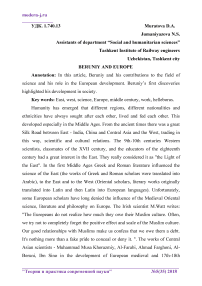Beruniy and Europe
Автор: Muratova D.A., Jumaniyazova N.S.
Журнал: Теория и практика современной науки @modern-j
Рубрика: Основной раздел
Статья в выпуске: 5 (35), 2018 года.
Бесплатный доступ
In this article, Beruniy and his contributions to the field of science and his role in the European development. Beruniy’s first discoveries highlighted his development in society.
East, west, science, europe, middle century, work, helleborus
Короткий адрес: https://sciup.org/140273255
IDR: 140273255
Текст научной статьи Beruniy and Europe
Humanity has emerged that different regions, different nationalities and ethnicities have always sought after each other, lived and fed each other. This developed especially in the Middle Ages. From the ancient times there was a great Silk Road between East - India, China and Central Asia and the West, trading in this way, scientific and cultural relations. The 9th-10th centuries Western scientists, classmates of the XVII century, and the educators of the eighteenth century had a great interest in the East. They really considered it as "the Light of the East". In the first Middle Ages Greek and Roman literature influenced the science of the East (the works of Greek and Roman scholars were translated into Arabic), to the East and to the West (Oriental scholars, literary works originally translated into Latin and then Latin into European languages). Unfortunately, some European scholars have long denied the influence of the Medieval Oriental science, literature and philosophy on Europe. The Irish scientist M.Watt writes: "The Europeans do not realize how much they owe their Muslim culture. Often, we try not to completely forget the positive effect and scale of the Muslim culture. Our good relationships with Muslims make us confess that we owe them a debt. It's nothing more than a fake pride to conceal or deny it. ". The works of Central Asian scientists - Muhammad Musa Khorazmiy, Al-Farabi, Ahmad Farghoni, Al-Beruni, Ibn Sino in the development of European medieval and 17th-18th centuries have made a great contribution to the creation of modern sciences in European countries. In this sense, it is one of the urgent tasks of today to introduce the rich scientific literary heritage left by our ancestors to the wider world and to ban their translation into other languages. It is well known that the tradition of translation and prohibition of works of ancient scholars, who lived and worked in Central Asia in Central Asia, began in the Middle Ages. According to sources, the European scientific community was acquainted with the achievements of academics such as Abu Ali ibn Sino and Ahmed Fargoni in various branches of science through the translations into Arabic from the 12th-13th centuries. Abu Rayhon Beruniy, the great scientist and thinker of the Central Asian awakening era, made a great contribution to the development of Oriental sciences. His rich scientific heritage in mathematics, natural sciences, geology, geodesy, culturology, ethnography, history, linguistics and literature has played an important role not only in the development of the Eastern world, but also in the European science. Beriniy's conclusions in various fields of science are of major importance today. The contribution of our ancestor to the development of European sciences is invaluable. Beruniy first discovered the turbulence of the Earth, once proving that Europe and Africa were one. According to him, there was a place between Alexandria (Alexandria, Egypt - JN) and Gustantania (Constantinople, present-day Istanbul - JN). Beruniy draws the first maps of the globe. They say that Al-Beruni is the name. Beruniy's name, "Helleborus", also derived from butterfly, is closer to the truth. However, the way in which the term was translated into novels has remained a puzzlement for many years. After the development of European natural sciences at a certain level, this has attracted the attention of many scientists. Translation of Beruni's works into European languages is in the 19th century in 1845, French Orientalist Joseph Raynaud first translated some chapters of Al-Beruni's book into India and studied it. In addition, the English scientist Eduard Zaho's service to introduce Al-Beruni's scientific heritage to Europe was unique. He published English in 1878-1888, "Indian" and "Old Remnants of the
East". These translations, on the other hand, began the process of translating and translating the scholarly work, and this process continues today. The proof of our opinion is the 1991 book by Gottkhard Stromay, published by the Creative Advertising Agency in Layps, in the book "Ilm fan gulshanasida". This book contains 317 pages and contains examples from Beruni's "India", "Ancient Monuments", "Cultural Studies" and "Geodesy", as well as on physicist questions with alumni Abu Ali Ibn Sino. In his introductory note to the book, Mutarjim, giving valuable information about the history of scientific cooperation between the East and the West, about the great geniuses of the Origen, emphasized Beruniy's image and its influence on Western science. The extensive volumetric bibliographical information and commentary at the end of the book shows that the author of the translation has come up with a unique preparation for this work. Beruniy looks at his genius with profound ghosts. "Beruniy is the most mature scientist of the medieval science in the East with its vastness of its interests, the depth of its views, its precise and fundamental research," he wrote.
Список литературы Beruniy and Europe
- Комилов Нажмиддин. Тафаккур карвонлари. - Т.: Маънавият, 1999.
- Крачковский И.Ю. Избранные сочинения, том II. - М.Л., 1956.
- Уотт У.М. Влияние Ислама на средневековую Европу. - М., 1976.
- Kennedy E.S. A letter of Jamshid al-Kashi to his father/ in: Orientalia NS, 1960.
- Stromaier Gotthard. Al-Biruni. / in: Den Gaerten der Wissenschaft. - Leipzig: Reclam-Verlag, 1991.


